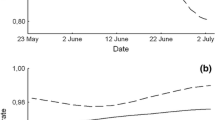Summary
In cyclically fluctuating vole populations, strong intraspecific competition and intense predation simultaneously or separately increase the costs of reproduction and so may set the framework for the optimal breeding tactic of voles. In a factorial experiment, we manipulated two factors in the breeding environment of bank vole (Clethrionomys glareolus) pairs, each with two treatment levels: no predation risk or high risk of specialist predators and low or high density of voles. In the manipulation, we used odours of conspecific voles and/or mustelid predators. Both over-wintered and young, summer-born, wild-caught bank vole females and males in breeding condition were used. Each female-male pair of voles was placed in a cage and the cages were distributed in large outdoor enclosures. All animals were fed ad libitum. Under predation risk, both old and young females suppressed breeding significantly. The density of conspecific voles did not affect overall breeding. However, there was some evidence that population density stimulated breeding of old females but suppressed breeding of young ones. Both risk factors appeared to increase litter sizes of those individuals who ‘decided’ to breed. Our results indicate that the risk of predation may be an important factor determining reproductive tactics of bank vole females. In risky environments, females seemed to choose between two totally opposite tactics: they suppressed breeding, which may increase their own survival to the next breeding event, or they continued to breed in spite of expected high survival costs. Females seemed to compensate the latter costs with a higher effort to the current and probably the last reproduction.
Similar content being viewed by others
References
Bell, G. (1980) The costs of reproduction and their consequences. Am. Nat. 116, 45–76.
Bujalska, G. (1985) Regulation of female maturation in Clethrionomys species, with special reference to an island population of C. glareolus. Ann. Zool. Fennici 22, 331–342.
Clutton-Brock, T.H., Guinness, F.E. and Albon, S.D. (1982) Red Deer: Behaviour and Ecology of Two Sexes. University of Chicago Press, Chicago, IL.
Cushing, B.S. (1985) Estrous mice and vulnerability to weasel predation. Ecology 66, 1976–1978.
Dobson, A.J. (1990) An Introduction to Generalized Linear Models. Chapman and Hall, London.
Hanski, I., Hansson, L. and Henttonen, H. (1991) Specialist predators, generalist predators, and the microtine rodent cycle. J. Anim. Ecol. 60, 353–367.
Hanski, I., Turchin, P., Korpimaki, E. and Henttonen, H. (1993) Population oscillations of boreal rodents: Regulation by mustelid predators leads to chaos. Nature 364, 232–235.
Hansson, L. and Henttonen, H. (1988) Rodent dynamics as community processes. Trends Ecol. Evol. 3, 195–200.
Heikkilä, J., Kaarsalo, K., Mustonen, O. and Pekkarinen, P. (1993) Influence of predation risk on early development and maturation in three species of Clethrionomys voles. Ann. Zool. Fennici 30, 153–161.
Henttonen, H., Oksanen, T., Jortikka, A. and Haukisalmi, V. (1987) How much do weasels shape the microtine cycles in the northern Fennoscandian taiga? Oikos 50, 353–365.
Kawata, M. (1987) Pregnancy failure and suppression by female-female interaction in closed populations of the red-backed vole, Clethrionomys rufocanus bedfordiae. Behav. Ecol. Sociobiol. 20, 89–97.
Koponen, T. (1970) Age structure in sedentary and migratory populations of the Norwegian lemming, Lemmus lemmus (L.), at Kilpisjärvi in 1960. Ann. Zool. Fennici 7, 141–187.
Korpimäki, E., Norrdahl, K. and Rinta-Jaskari, T. (1991) Responses of stoats and least weasels to fluctuating food abundances: Is the low phase of the vole cycle due to mustelid predation? Oecologia 88, 552–561.
Korpimäki, E., Norrdahl, K. and Valkama, J. (1994) Reproductive investment under fluctuating predation risk: Microtine rodents and small mustelids. Evol. Ecol. 8, 357–368.
Koskela, E. and Ylönen, H. (1995) Suppressed breeding in the bank vole (Microtus agrestis): An adaptation to cyclically fluctuating predation risk. Behav. Ecol. 6, 311–315.
Magnhagen, C. (1990) Reproduction under predation risk in sand goby, Pomatoschistus minutus, and the black goby, Gobius niger: The effect of age and longevity. Behav. Ecol. Sociobiol. 26, 331–335.
Mappes, T., Ylönen, H. and Viitala, J. (1995) Higher reproductive success among kin groups of bank voles (Clethrionomys glareolus). Ecology 76, 1276–1282.
Norrdahl, K. (1993) Predation risk constrains reproduction in cyclic vole populations. PhD thesis, University of Helsinki.
Roff, D.R. (1992) The Evolution of Life Histories. Chapman and Hall, New York.
Ronkainen, H. and Ylönen, H. (1994) Behaviour of cyclic bank voles under risk of mustelid predation: Do females avoid copulations? Oecologia 97, 377–381.
Schaffer, W.D. (1974) Selection for optimal life histories: The effects of age structure. Ecology 5, 291–303.
Stearns, S.C. (1976) Life-history tactics: A review of the ideas. Q. Rev. Biol. 51, 3–47.
Tuomi, J. (1990) On clutch size and parental survival. Oikos 58, 387–389.
Ylönen, H. (1989) Weasels Mustela nivalis suppress reproduction in cyclic bank voles Clethrionomys glareolus. Oikos 55, 138–140.
Ylönen, H. and Ronkainen, H. (1994) Breeding suppression in the bank vole as antipredatory adaptation in a predictable environment. Evol. Ecol. 8, 658–666.
Ylönen, H., Kojola, T. and Viitala, J. (1988) Changing female spacing behaviour and demography in an enclosed breeding population of Clethrionomys glareolus. Holarctic Ecol. 11, 286–292.
Author information
Authors and Affiliations
Rights and permissions
About this article
Cite this article
Mappes, T., Ylonen, H. Reproductive effort of female bank voles in a risky environment. Evol Ecol 11, 591–598 (1997). https://doi.org/10.1007/s10682-997-1514-1
Issue Date:
DOI: https://doi.org/10.1007/s10682-997-1514-1




